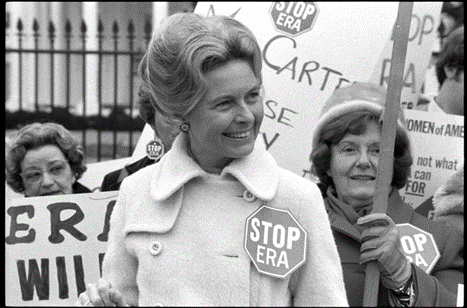Contextual Overview
In the beginning of the 1970s, the feminist movement was gaining quite a lot of ground. Many laws were being put into action that catered to the feminist agenda. This included the addition of the Title IX section to the education amendments and the allowance of birth control rights to unmarried women across America.
Feminists of this time sought real equality between men and women. They wanted equal pay as well as equal opportunity to seek jobs and career paths that were typically only for men. They also wanted to be freed of domestic life by having the government provide child-care services—this way the women could have more opportunity to work outside of the home. Some feminists spoke of wanting to hold the same powers as men; they basically wanted to disestablish the power that men held over women simply because they were born male.
One of the biggest priorities for the women’s liberationist movement was enacting the Equal Rights Amendment, or ERA. This amendment had been written up decades prior and was brought to the attention of Congress many times since 1923, but it did not receive enough attention to get passed through the House and Senate floors until the early 1970s.
The vision of the ERA was to allow true equality between men and women in all areas of life. This is what Phyllis Schlafly, and other women who enjoyed their domestic lives, could not understand. They believed that women had freedom in their domestic lives and that wanting equality between men, among other things, would mean taking away the safeties that women had in America. So, after Schlafly heard about the ERA becoming more popular and speaking to other women who appreciated the lives that they had in America, she chose to take decisive action in order to keep her lifestyle intact.

Wikimedia Commons
Biography
Phyllis Schlafly lived from 1924 to 2016. She was a wife and a mother, but she was also an advocate against the women’s liberationist movement.
Schlafly grew up in a roman catholic, conservative household during the Great Depression. Her father lost her job, so her mother stepped up and took over two different jobs in order to care for their family during this time.
Schlafly also excelled in school and when she found her first college situation too simple, she opted for a more rigorous program at Washington University and, later on, Radcliffe College. By working factory night shifts, she was able to pay her college tuition. She earned a bachelor’s degree in political science and her master’s in government. She even served as the leader of the Illinois Federation of Republican Women from 1960 to 1964. After that, she began writing regularly to inform people about political issues. Although not all of her efforts pushed political issues to go the way she wanted, she continued to do the work that she set out to do.
Despite all these events, Schlafly was still against feminist ideas.
She married John Fred Schlafly Jr., who was a wealthy attorney, in 1949. Her husband allowed her to pursue a law degree after realizing it would help in her fight against the ERA. Fighting this amendment is what Schlafly is most remembered for. Her efforts are highly credited for lessening the ERA’s popularity and finally not being voted into law. She spoke and organized demonstrations against the ERA and pushed heavily against the women’s liberationist movement.
Schlafly also wrote many books in her lifetime. She wrote to push her conservative agenda, making arguments for and against different people and policies. Now, there are 27 published books that she either wrote or co-wrote.
Text Analysis
Schlafly used strong tactics to push her views on other women and persuade them into believing that progressive ideas would only do damage to society. Some of her ideas can be seen in her book, The Power of the Positive Woman. Schlafly gained a lot of support by assertively partnering widely accepted statements with her own conservative ideals, producing an air of knowledge; people with similar ideas or backgrounds could turn to favor her direction.
The book excerpt in analysis is the first 13 pages of The Power of the Positive Woman, which was published in 1977. It’s a persuasive piece, outlining her view of what it looks like to be a healthy American woman—as a wife and a mother—opposed to what it looks like to be a feminist, pushing Americans to turn to her conservative ideals and/or start making noise about them.
Schlafly associates “the Positive Woman” with good behavior and pokes fun at women’s liberationists and describes them in a foolish light, belittling their beliefs. She also makes a point to say they choose to make enemies of men, which Schlafly believes to be one of the biggest mistakes made by women’s liberationists. In her own words, “By its very nature, therefore, the women’s liberation movement precipitates a series of conflict situations…with man targeted as the enemy. …Women and men become adversaries instead of partners” (Schlafly, 1979). By her assertions, one could infer that conservative women during this time found it more appealing to contest with other women, rather than men. This can aid in explaining their passionate fight against the ERA.
“lesbianism is logically the highest form in the ritual of women’s liberation”
Phyllis Schlafly
A lot of Schlafly’s influences came from her Christian background, as well as her white and upper-class background. From her perspective, the ERA would make little positive difference to her lifestyle. She believed that new abortion and LGBTQ choices, of which she disagreed with, were soon going to be legally permitted if the amendment became law. She concluded that “lesbianism is logically the highest form in the ritual of women’s liberation” and made it clear that the Positive Woman knew “baby-producing organs [were] not designed by a conspiracy of men, but by the Divine Architect of the human race” and that the fact should be celebrated, instead of protested (Schlafly, 1979). This is a prime example of her using knowledge that most people could agree on to accompany her own deductions or ideas.
Legacy
What Phyllis Schlafly did, essentially, was inspire fear into some American women that equality with men would take away whatever safety and protection they had without the ERA in action. With this fear being placed into women, some men also began to believe it was unnecessary to put women through such conditions of life.
Schlafly’s most prominent work is seen as the fight she led against the Equal Rights Amendment, and her efforts are credited for making sure the amendment wasn’t ratified. It is true that Schlafly organized the STOP ERA movement and garnered a lot of vocal support as well as women who were ready to stand by her and protest the amendment with her. Some would say that the division of many feminists is what made it so difficult to gain support on the ERA and gain support in general when it came to the feminist agenda in the 1970s, after Schlafly started to work against women’s liberationists. In any case, though, her STOP ERA campaign had a large impact on the success of the amendment, or lack thereof.
She wrote many books and participated in periodical writings and other media creations, including her very last work that advocated for President Trump. Of her most recollected works are the latter, The Conservative Case for Trump, her first publishment, A Choice Not An Echo, and her most popular piece against feminism and the women’s liberationists, The Power of the Positive Woman. These books and other forms of media hold her thoughts and continue to show what kinds of things she believed in while she was alive. The words that she leaves behind for future leaders or conservatives can be counted as a part of her legacy.
One thing that she received reproof for was the fact that she advocated for domestic life for women—taking care of children, cleaning and working at home—but her political work undermined this kind of advocacy.
All of the schooling she’d gone through shows that she was prepping for a thought-filled life ahead that would take her out of her home in some fashion. This would be evident even if she ended up staying in her home due to her husband’s cautions. However, it seems she was allowed to go out and work, and she did so fervently. She once said “My husband lets me do what I want to do. I have canceled speeches whenever my husband thought that I had been away from home too much” (Kettler, 2020). So, at times, she was away from her children and away from her housework—as one could often be if they are working so passionately in political matters. The heavy work she took on in politics took her away from domestic life, which goes against the very thing she was trying to protect throughout her career.
Phyllis Schlafly was a well-educated woman who used outstanding skills of persuasion, as well as charm, to push her conservative agenda. Although there were many feminists then, and likely many now, that disagree with her and her tactics, she did strong work and continues to be an interesting subject for study and analysis.
Further Reading
Bergeron, Ryan. ‘The Seventies’: Feminism Makes Waves. 17 Aug. 2015, www.cnn.com/2015/07/22/living/the-seventies-feminism-womens-lib/index.html.
Boissoneault, Lorraine. “The 1977 Conference on Women’s Rights That Split America in Two.” Smithsonian.com, Smithsonian Institution, 15 Feb. 2017, www.smithsonianmag.com/history/1977-conference-womens-rights-split-america-two- 180962174/.
Cunningham, John M. Phyllis Schlafly, Encyclopædia Britannica, 1 Sept. 2020, www.britannica.com/biography/Phyllis-Schlafly.
Kettler, Sara. Phyllis Schlafly. 1 Apr. 2020, www.biography.com/political-figure/phyllis- schlafly.
“Preface” and “Understanding the Difference.” The Power of the Positive Woman, by Phyllis Schlafly, Arlington House, 1979, pp. 1–13.
